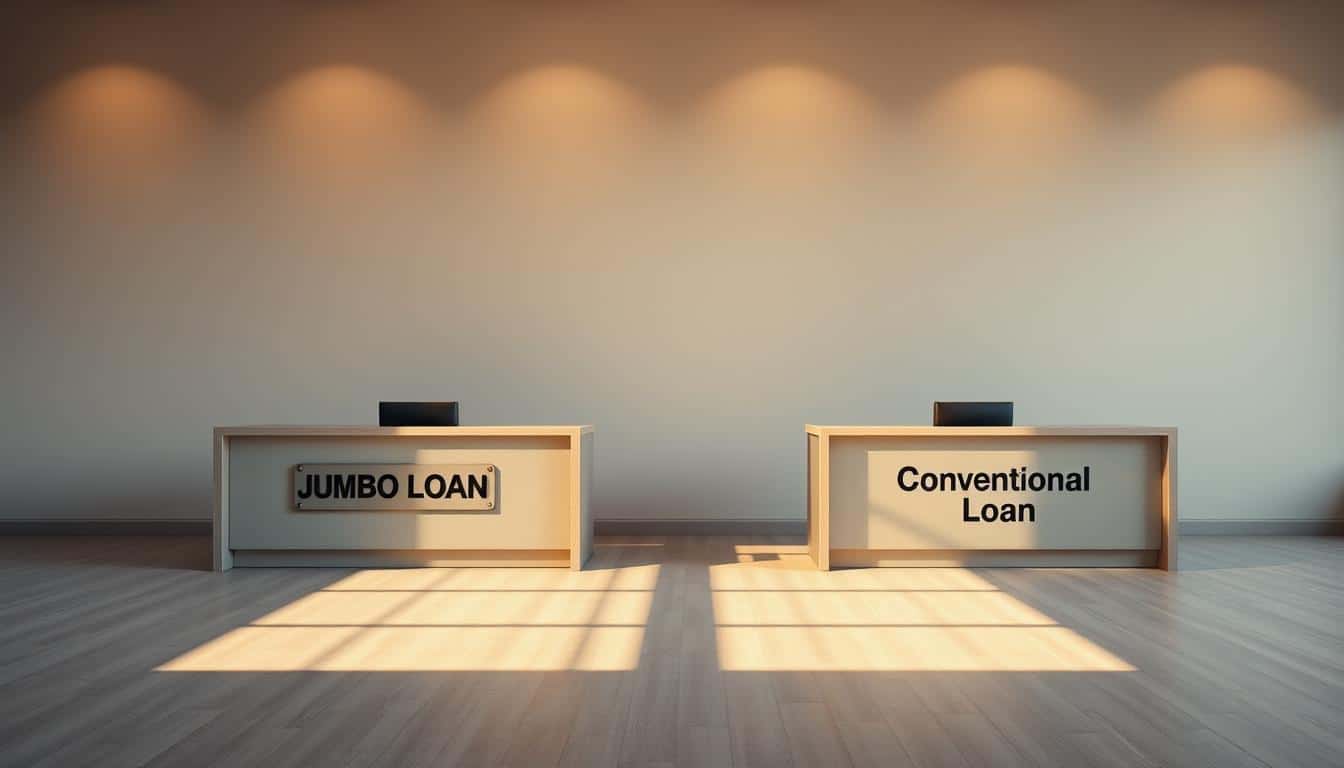Table of Contents
Have you ever wondered How Does a Jumbo Loan Differ from a Conventional Loan. A jumbo loan can pack some surprising perks you won’t find elsewhere, so carefully comparing your options pays off. If you’re in the market for a home, knowing how jumbo loans and conventional loans stack up side by side is a must.
Regular loan limits sit at $807,700 for most U.S. counties, but in areas with sky-high home prices the ceiling can soar past $1.2 million. In this post, we’ll break down the biggest differences: how much you can borrow, the interest rates you’re offered, and the tougher paperwork you’ll face when applying. By the end of the article, you’ll know which loan fits your budget and goals.
Key Takeaways
- Conforming loans stick to Fannie Mae and Freddie Mac limits, which usually cap at about $806,500 for 2024.
- In contrast, jumbo loans can stretch into the millions; the exact ceiling depends on the mortgage lender.
- While many conventional loans settle with at least a 620 FICO score, jumbo loans usually expect a 700 or higher.
- Your down payment for a jumbo loan rates can sit between 20% and 25%, while conventional options may start at only 3% to 5%.
- If you’re looking at reserves, jumbo lenders may ask for 6 to 12 months of mortgage payments set aside, versus 3 to 6 months for conventional loans.
- You’re likely to see slightly higher interest rates on jumbo loans, which reflect the additional risk a lender takes.
- Finally, these loans often require manual underwriting, so plan for a longer wait for final approval.
Understanding Jumbo Loans
Ever hear about mortgage loans for a high-end mansion? That’s where jumbo loan rates come in. These loans let homebuyers purchase very expensive properties that exceed the limits set by the government. The Federal Housing Finance Agency (FHFA) writes these caps each year.
What is a Jumbo Loan?
A jumbo loan rates are simply a mortgage that’s larger than what the FHFA allows. For most counties in the U.S., that ceiling starts at $766,550 for a single-family home. In high-cost areas, the limit can reach $1,149,825. Since these amounts sail past FHA and FHA backing, jumbo loans come with more flexible terms and tougher approval hurdles.
Must-Know Jumbo Loan Traits
Jumbo loan rates have some standard requirements. Expect to have a credit score of at least 700. Any lower raises the lender’s risk, so the terms become stricter. While some lenders accept a 10% down payment, the typical borrower forks over 20% to 30% of the purchase price.
Lenders also check your debt-to-income (DTI) ratio, which must remain under 45%. This ratio compares your monthly debt to your gross monthly earnings, helping lenders gauge how much of your paycheck you can send to a mortgage each month. The paperwork for jumbo loan rates are heavier, too— tax returns, W-2s, and pay stubs for the past two years. Expect higher interest rates and additional fees that can push the loan’s total cost higher over the years.
Overview of Conventional Loans
Conventional loans are mortgage options that don’t carry government insurance, making them a top pick for private mortgage lenders. They come in two flavors: conforming and non-conforming. Conforming loans meet standards set by the Federal Housing Finance Agency, or FHFA. For 2024, the limit on these loans is $766,550 in most counties, but in some high-cost areas it can go as high as $1,149,825.

Definition of Conventional Loans
Conventional loans are home loans that fee companies backed by government-chartered bodies can buy. That backing lets banks set their own terms, often resulting in lower rates compared to jumbo loan rates. You can usually put down 3% to 20% and need a credit score score of at least 620.
Key Characteristics of Conventional Loans
Conventional loans come with a lot of advantages. Your debt-to-income ratio can go up to 50%, which eases the qualification process. If you put down less than 20%, you will pay Private Mortgage Insurance or PMI until you build enough equity. For side-by-side comparisons, check out our post on conventional vs jumbo rates.
Loan Limits Explained
To avoid surprises at the closing table, you need to know which limits apply to which loans. Conventional limits are set every year by the Federal Housing Finance Agency, or FHFA. That limit tells you the most you can borrow and still qualify for a conforming loan. For 2024, that limit is $806,500 in most of the country.
In places where the cost of housing is much higher, such as Alaska and Hawaii, the limit jumps to $1,209,750 because home prices are simply higher in those regions.
What Are Conventional Loan Limits?
Conventional loan limits are caps set on how much money you can borrow for a home without special government insurance. Generally, this amount is $806,500 in most areas, but some counties, like Denver, raise it to $816,500 to match rising home prices. These limits give lenders a quick way to measure risk, so loan amounts above the cap require different backup and rules.
By capping the amount, limits protect both sides. Borrowers know upfront how much they can safely borrow, while lenders avoid being stuck with a loan that’s too big for the insurance they might use. Ultimately, the limits create a fairer process that can help more people lock in a loan.
How Jumbo Loan Limits Differ
When home prices leap, some buyers need more money than the conventional caps allow. Jumbo loans step in here. These loans can be millions, depending on the area, and are available when a home’s worth races past the standard limits.
Since jumbo loan rates are not backed by government giants like Fannie Mae and Freddie Mac, they come with stricter guidelines. Buyers need a higher credit score, a bigger down payment, and backup cash. These stricter rules help lenders feel more secure when the loan amount crosses into higher territory.
Interest Rates Comparison
When weighing a conventional loan against a jumbo option, pay close attention to interest rates. Though jumbo rates can sometimes look higher, they move differently based on your credit profile and market conditions. A borrower with strong credit might get a rate on a jumbo that’s close to a conventional loan with a lower amount. Evaluate all numbers side by side to see how the rate choice impacts your monthly payment and long-term cost.
Interest Rates for Jumbo Loans
As of December 2023, the standard interest rate for a 30-year fixed jumbo loan sits at 7.54%. The 15-year version is averaging approximately 6.85%. Jumbo loans carry a slightly steeper rate than conventional options since the loan amount exceeds conforming limits, making them a bigger risk for the lender.
Typically, the rate gap between jumbo loan requirements and conventional financing can swing between 0.25% and 1%. The exact difference hinges on the borrower’s credit profile, the size of the down payment, and overall financial stability. That gap, combined with today’s high rates, can translate into significantly larger monthly payments. Borrowers should independently verify that their budget can absorb the higher cost.
Interest Rates for Conventional Loans
Meanwhile, conventional loans are frequently issued at more attractive terms. Rates adjust relative to the loan size and the borrower’s credit score. Right now, a 30-year fixed conventional mortgage is being quoted around 7.06% for the same risk tier, which is at least 0.48% cheaper than jumbo financing for some consumers.
Because conventional loans are more flexible on size, they work well for homebuyers requiring smaller loans and a lower monthly budget. With an interest rate lower than jumbo’s for the bulk of loans, these mortgages offer the more appealing choice for many transactions. That’s why it’s crucial to compare both jumbo and conventional rates before locking in a mortgage.

Down Payment Requirements
Figuring out your mortgage down payment is a big part of the home-buying process. A jumbo loan requirements and a conventional loan each have different down payment needs, and understanding these numbers helps you make the best choice for your wallet. Your personal finances will guide how much cash you can put down.
Jumbo Loan Down Payment Expectations
A jumbo loan usually comes with a larger down payment, often between 10% and 25% of the home price. Since jumbo loans cover more expensive homes, lenders want reassurance that the borrower can manage the costs. For a $1 million home, for example, a 10% down payment would be $100,000. Buyers will want a saving plan that can support this kind of cash out of pocket.
Conventional Loan Down Payment Options
Conventional loans are more flexible, offering starting down payments as low as 3%. On a $300,000 home, that breaks down to $9,000, making the deal more doable for first-time buyers or anyone who hasn’t stocked away years’ worth of cash. Loan programs like Conventional 97, Fannie Mae HomeReady, and Freddie Mac Home Possible support these low down payments, but many will require you to take on private mortgage insurance (PMI) until the home grows to at least 20% in value.
Keep these down payment requirements in mind, since today’s housing market is ever-changing.
Credit Score Criteria
Understanding the credit score guidelines for jumbo and conventional loans is crucial. A solid credit score is one of the first things lenders check because it shows you handle your finances responsibly.
Credit Requirements for Jumbo Loans
To qualify for a jumbo loan, lenders usually require credit scores of at least 700. Some may even ask for scores of 740 or higher to offer the best rates. These higher marks protect lenders, as jumbo loans exceed the limits set for government-backed mortgages.
To improve your chances, keep your credit record clean. Pay bills on time, reduce debts, and avoid new charges before applying. A stronger score not only boosts approval odds— it can also lower your monthly payment by qualifying you for a lower interest rate.
Credit Requirements for Conventional Loans
Conventional loans are more flexible. They accept scores beginning at 620. That lower threshold makes the loan type available to buyers with varied credit histories. Still, a better score helps. If you are above 740, lenders often offer lower interest for conventional mortgages.
Underwriting Process
Underwriting examines your whole financial picture— not just the score. Lenders check your income, debts, assets, and the property’s value to assess risk. Conventional and jumbo loans each have their own guidelines. Jumbo underwriting is usually more detailed, focused on how buyers can sustain mortgage payments beyond the loan’s upper limits.
Understanding these guidelines helps you compare financing and choose the option that best fits your situation.
Jumbo Loan Underwriting Steps
When it comes to jumbo loan requirements, the approval process is a bit more of a workout. Jumbo loan requirements exceed the standard loan limit, so lenders dig into the borrower’s entire financial picture. They pay extra attention to income sources, pay stubs, bank statements, and retirement accounts, leaving no stone unturned.
Because of the extra scrutiny, it’s wise to gather all the documents beforehand. Expect tasks like calculating the full debt-to-income ratio and possibly showing twelve months’ worth of cash reserves. That extra layer of caution adds to the time it takes to get an official thumbs-up.
Conventional Loan Underwriting Steps
Compare that to a conventional loan, where the process is quicker and fairly straightforward. Lenders keep a broader set of approval guidelines, which means less paperwork and a faster pace.
The loan limit can reach $1,149,825 in high-cost markets, and the borrower can have a debt-to-income ratio of up to 50%. A credit score of 620 is the minimum, and only six months of cash reserves are needed. These relaxed criteria explain why many people find conventional loans the faster option.
Key Details on Private Mortgage Insurance
Anyone shopping for a mortgage is wise to factor in private mortgage insurance, or PMI. PMI is the lender’s safety net in case the borrower runs into financial trouble. Since the coverage shifts depending on loan size and type, it’s a good idea to learn how it’s calculated in both the jumbo and conventional markets. Understanding PMI can keep a home budget—and an entire financial plan—on solid ground.
PMI on Jumbo Loans
Typically, jumbo loan requirements do not come with PMI. That’s mainly because borrowers are usually asked to make at least a 20% down payment. With such a large upfront contribution, the lender feels more secure, so they skip the insurance altogether.
Skipping PMI translates to sizable savings each month. Instead of paying an insurance premium, the extra funds go directly into building your home’s equity.
PMI on Conventional Loans
Conventional mortgages, on the other hand, call for PMI when the down payment is smaller than 20%. Even with as little as 3% down, the lender will add PMI to the monthly payment. The annual cost can range from 0.1% to 2% of the loan’s amount.
How much PMI you actually pay depends on the size of your down payment and your credit score. The good news is that, once you reach 20% equity, you can petition the lender to drop the coverage. If you wait, PMI will automatically end when your balance hits 78%. Being aware of these rules can help you plan the loan that’s right for you.

Why Go with Elite Lending Service?
Buying a home is hard enough without wondering if the mortgage is the right fit. A local pro who knows the market can make all the difference. At Elite Lending Service, Brad Bailey and his team have helped North Florida buyers for years land jumbo and conventional loans so they can settle into the right home sooner.
Knowledge You Can Count On
With Elite, loans aren’t one-size-fits-all. The team custom-builds solutions around each buyer. They can match you with dozens of programs, including the Turquoise Jumbo option for borrowers eyeing higher-priced properties. That makes jumbo financing feel simple, even if it sounds complicated.
What you really get is a partner. The crew sorts through your pay stubs, bank statements, and credit with you, spotlighting the pros and cons. They break down how the numbers work, including any tax breaks for jumbo buyers. That way, there aren’t any surprises later. Have questions? Call Elite Lending Service at (904) 263-0376 or drop a note to brad@elitelendingservice.com for a prompt reply.
FAQ
What is the main difference between a jumbo loan and a conventional loan?
What are the typical requirements for obtaining a jumbo loan?
Do jumbo loans require private mortgage insurance (PMI)?
What are the interest rates for jumbo loans compared to conventional loans?
How do down payment requirements compare between jumbo and conventional loans?
What credit score do you need for a jumbo loan?
How do the underwriting processes differ?
What are the conforming loan limits for 2024?
FAQ
What is the main difference between a jumbo loan and a conventional loan?
Jumbo loans are bigger than the limits the Federal Housing Finance Agency (FHFA) sets. Because they fall outside the limit, they don’t have government support. Conventional loans stay below the limit and may get that backing, making them a bit safer.
What are the typical requirements for obtaining a jumbo loan?
To land a jumbo loan limits, you usually need a 700-plus credit score. A hefty down payment between 20% and 25% is the norm. You’ll face a rigorous loan process that asks for lots of financial details like bank statements and income proof.
Do jumbo loans require private mortgage insurance (PMI)?
Most jumbo loans skip PMI because you’re already invested in a large down payment. Conventional loans will often require PMI if the down payment is below 20%, which adds an extra monthly cost.
What are the interest rates for jumbo loans compared to conventional loans?
Interest rates for jumbo loan limits are often a little higher—roughly 0.25% to 1% more than conventional loans—because lenders see them as riskier. Keep an eye on the market trends since rates can shift week to week.
How do down payment requirements compare between jumbo and conventional loans?
Jumbo loan requirements generally require a down payment of 10% to 25%, while conventional loans can start as low as 3% to 5%. Because of this, first-time homebuyers may find conventional loans a better fit.
What credit score do you need for a jumbo loan?
For a jumbo loan, you’ll need a credit score of at least 700. Conventional loans may allow scores starting at 620, making them accessible to a wider range of borrowers.
How do the underwriting processes differ?
Jumbo loans undergo a stricter and more detailed underwriting process, so loan approval takes longer. Conventional loans have a simpler process, which means they usually close more quickly.
What are the conforming loan limits for 2024?
For 2024, the conforming loan limit for most areas is $766,550. In high-cost regions, the limit is $1,149,825. Loans above these amounts, known as jumbo loans, offer even larger borrowing possibilities.
Why Pick Elite Lending Service for Your Mortgage?
If you’re looking for a trusted partner to help you secure a mortgage, Elite Lending Service—led by Brad Bailey—could be a great choice. With 20 years in the business, Brad and his team know the market inside and out. They specialize in both jumbo and conventional loans for North Florida, so whatever your need, they have the expertise to match. You won’t feel overwhelmed navigating the paperwork or the deadlines; the Elite team makes every step clear and manageable.




